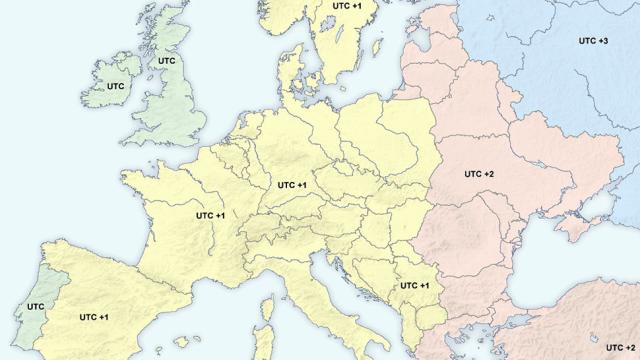If your economy isn’t doing so well, just jump into another time zone. This is the strategy pursued by Samoa, for example, which rather dramatically leapt across the International Date Line back in 2011 in order to align its work-week more closely with its Pacific neighbours; and a more local version of this might be the next step for Spain, according to a proposal being kicked around since September.
Spain, the New York Times reports, is considering “turning back the clocks an hour, which would move Spain out of the time zone that includes France, Germany and Italy. Instead, Spain would join its natural geographical slot with Portugal and Britain in Coordinated Universal Time, the modern successor to Greenwich Mean Time.”
As seen in the map, above, this would also put it into the timezone its geographic location much more clearly deserves, aligned with Portugal and the UK (and also nudging it one hour closer to the United States). A country’s time zone is thus an explicit economic calculation, a financial strategy played out through clocks.
What’s particularly interesting about this, however, is that Spain — like Samoa, which had originally been west of the International Date Line but jumped eastward to time itself with the US work week, before moving back west again in 2011 — has already changed its time zone, and it did it to be closer to the Nazis.
Again, from the New York Times: “The national schedule can be traced to World War II, when the Spanish dictator Francisco Franco moved the clocks forward to align with Nazi Germany, as also happened in neighbouring Portugal. After the defeat of Hitler, Portugal returned to Greenwich Mean Time, but Spain did not.”
The current Spanish proposal is apparently just that — a proposal, not an actual plan, and certainly not yet a law — but the idea, at the very least, is drawing media attention. But this vision of entire nation-states leapfrogging time zones, sliding from day to the next, from the afternoon back into the morning, toward London and away from Berlin, and weaving back and forth like a basketball player over the International Date Line in the middle of oceanic nowhere, is an astonishing one, suggesting a kind of temporal free-for-all in which we can redesign not just our nations’ geographic borders, but the very present moment those nations choose to occur within.
Briefly, I’m reminded of something polar explorer Ben Saunders told me when we interviewed him for Gizmodo before his departure for Antarctica last autumn. Due to the fact that he and his companion, Tarka L’Herpiniere, would be hiking in 24-hour sunlight at the height of the Antarctic summer, they could literally just pick a time zone and stick with it. It didn’t matter if it was on the other side of the planet or if it had any connection at all to where they were camping; hiking down there amidst the convergence of time zones, where all calendars break down at the pole, they could say the time was — well, whatever they wanted it to be. They could align themselves with New York, London, New Zealand, or Chile, or perhaps even move back and forth between those zones, based on a bad night’s sleep or an unexpected burst of energy.
Spain and Samoa are thus like much larger versions of this, temporal explorers navigating the calendar with a will of their own, ploughing headlong through the days and hours till they find a present moment that suits them. [New York Times, Gawker]
